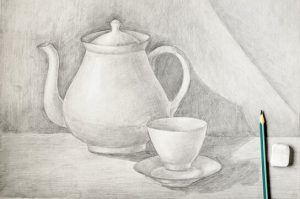Still life drawing is a timeless and captivating art form that involves depicting inanimate objects arranged in a composition. This type of drawing allows artists to focus on capturing the subtle details of everyday items like fruit, vases, or household objects. The beauty of still life lies in its ability to showcase the artist’s observational skills, use of light and shadow, and understanding of form.
A Guide to Still Life Drawing
Still life drawing, the art of depicting inanimate objects, offers a wonderful way to hone your artistic skills and observe the world around you in close detail. Whether you’re a seasoned artist or a curious beginner, this guide will provide you with the knowledge and inspiration to embark on your still life drawing journey.
Gathering Your Supplies:
- Pencils: A set with HB, 2B, and 4B pencils will give you flexibility for sketching, outlining, and shading
- Paper: A sketchbook with medium-weight paper is ideal for practicing and experimenting.
- Eraser: A kneaded eraser gently lifts graphite, while a vinyl eraser tackles larger areas
- Sharpener: Keep your pencils sharpened for precise lines and details.
- Drawing board (optional): Provides a stable surface for your paper and prevents smudging.


Mastering the Basics of Still Life Drawing
Mastering the basics of still life drawing is about building a solid foundation for crafting captivating compositions and breathing life into inanimate objects. Here are some tips to take your skills to the next level:
Sharpening Your Drawing Tools:
- Line weight: Master the art of varying your line thickness. Use light lines for outlines and delicate details, and bolder lines for emphasis and shadows.
Shading: Experiment with different shading techniques like hatching, cross-hatching, and stippling to create depth and dimension. Pay attention to light source and how it affects shadows.
- Perspective: Learn basic one-point and two-point perspective to add realism and depth to your still life arrangements.
Crafting Compelling Compositions:
- Rule of thirds: Divide your drawing space into thirds both horizontally and vertically. Place important elements at the intersections of these lines for a balanced and dynamic composition.
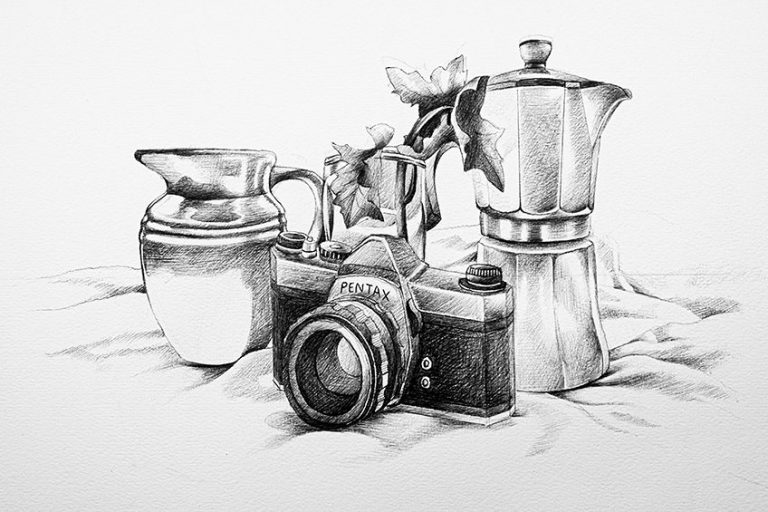
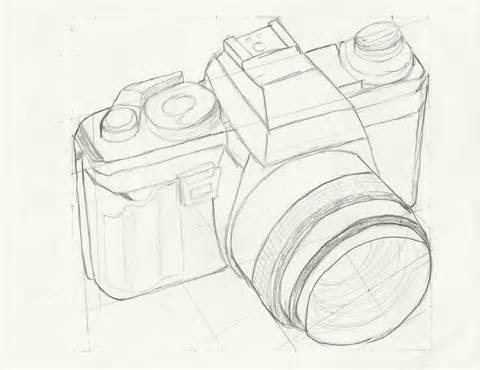
Still Life Drawing for Beginners
Still life drawing, the art of capturing inanimate objects on paper, is a fantastic way to start your artistic journey! Even beginners can create beautiful and expressive still lifes with a little guidance and the right approach. Here’s your beginner’s guide to still life drawing:
Setting Up Your Still Life:
- Choose your objects: Select a variety of shapes, textures, and colors for visual interest. Start with simple objects like fruits, vegetables, books, or everyday items.
- Arrange your objects: Consider composition and balance. Play with heights, angles, and overlapping elements to create a dynamic arrangement. Leave some negative space for breathing room.
- Lighting: Natural light is ideal for beginners. Choose a spot with soft, diffused light that avoids harsh shadows.
Getting Started with Your Drawing:
- Basic shapes: Break down each object into simple geometric shapes like spheres, cylinders, cubes, and cones. This simplifies the drawing process.
- Outlining: Use light pencil strokes to sketch the contours of your objects, paying attention to proportions and relationships between them.


A Step-by-Step Save Still Life Drawing
To create a captivating still life drawing that you can proudly save and cherish, let’s embark on a step-by-step journey with a twist towards sustainability! We’ll incorporate simple, eco-friendly elements to add a unique touch to your artwork.
Gather your materials:
- Recycled paper: Use an old cardboard box, brown paper bag, or torn scrap paper to create your drawing surface. This adds a recycled texture and saves new paper.
- Sketch pencil: Opt for a refillable pencil or sharpen your existing one carefully to minimize waste.
- Natural light: Position your setup near a window for soft, diffused lighting. Avoid artificial lights for a more harmonious feel.
- Natural objects: Select fruits, vegetables, leaves, or twigs from your garden or local market. This promotes local produce and avoids plastic packaging.
- Compostable eraser: Choose a natural rubber eraser that can be composted, reducing plastic waste.
Step 1: Lay the foundation:
- On your recycled paper, lightly sketch the outlines of your chosen objects. Pay attention to their basic shapes and arrangement.
- Use light, flowing lines to avoid smudging on the textured paper.
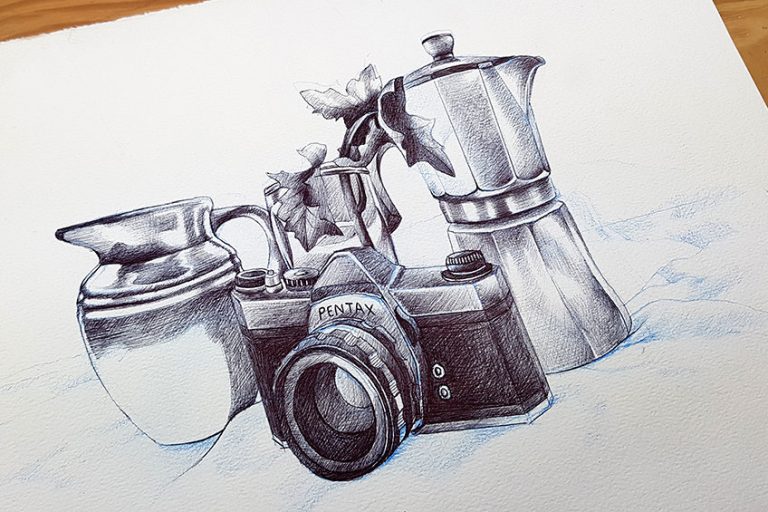
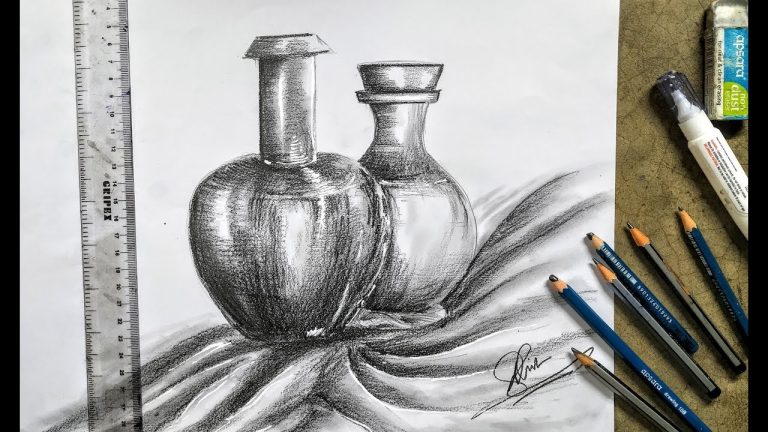
Still Life Drawing Techniques
Still life drawing, the art of rendering inanimate objects on paper, offers a rewarding journey for artists of all levels. Let’s dive into some essential techniques to elevate your still life drawings and capture the essence of your chosen subjects:
Composition and Arrangement:
- The Rule of Thirds: Divide your drawing space into thirds horizontally and vertically. Place important elements at the intersections for a balanced and dynamic composition.
- Negative Space: Utilize the empty space around your objects to create visual interest and balance. Don’t overcrowd the space.
- Focal Point: Guide the viewer’s eye by introducing a dominant element, like a brightly colored object or a strong contrast, to draw attention.
Drawing Techniques:
- Line Variation: Master the art of varying your line thickness. Use light lines for outlines and delicate details, and bolder lines for emphasis and shadows.
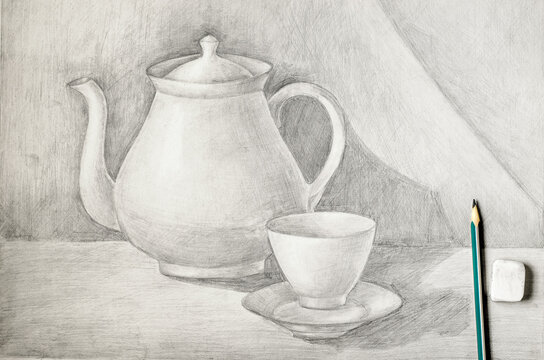
Frequently Asked Questions (FAQs)
Still life drawing serves multiple purposes. It helps artists improve their technical skills, such as observation, proportion, and shading. It also allows for experimentation with composition, lighting, and textures. Additionally, still life drawings often capture the beauty in ordinary objects, fostering an appreciation for the details of everyday life.
No, formal art training is not necessary for still life drawing. It is a versatile and accessible form of art suitable for beginners and experienced artists alike. Still life drawing can be a great starting point for those who are new to art, providing a foundation for more complex techniques.
When setting up a still life composition, consider the arrangement of objects, lighting, and background. Choose objects with interesting shapes, textures, and varying sizes. Experiment with different lighting conditions to create shadows and highlights. A simple backdrop, like a plain cloth, can help emphasize the objects.
Related posts:
- Lord Shiva Drawing : The Spiritual Essence in Shiva Artwork
- Parrot Drawing
- Pencil Drawing Images : A Beginner’s Guide to Drawing
- Pencil Drawing Pictures : Simple Steps for Drawing
- Pokemon Drawing : Pokemon Drawing for Beginners
- Rabbit Drawing : A Guide to Rabbit Drawing
- Republic Day Drawing : Republic Day Drawing Ideas
- Save Earth Drawing : Drawing for Beginners
